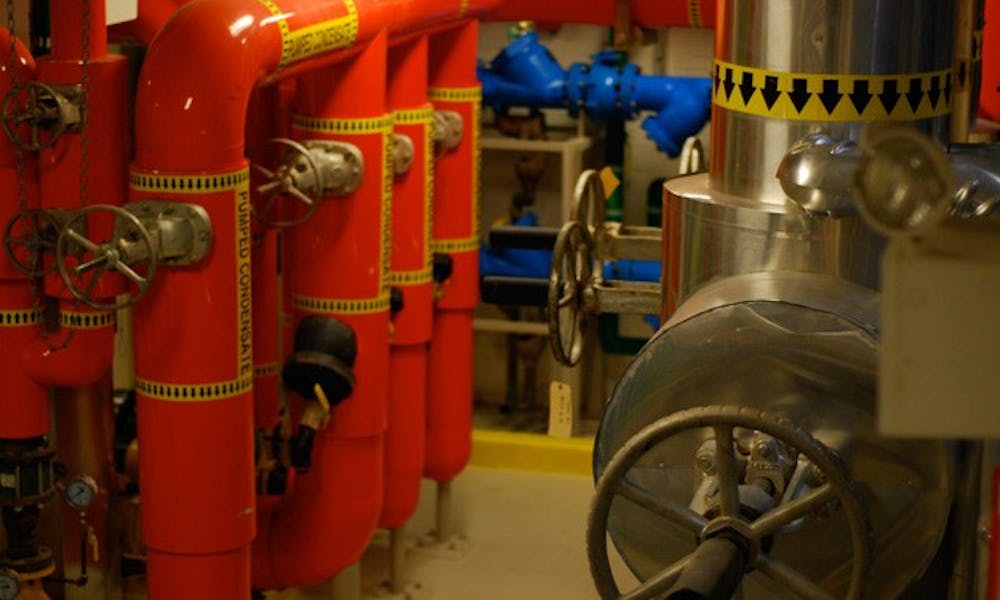Towering 175 feet above Campus Drive, the smokestack of the East Campus Steam Plant stands as a striking reminder of Duke’s past.
Although visibly notable, the stack no longer serves any practical purpose. A $26 million renovation completed in 2009 converted the coal heating plant to a natural gas steam plant.
“The stack today is nothing but decorative architectural feature,” said Russell Thompson, director of utilities and engineering for Facilities Management.
Although the plant was constructed in 1929, the renovation equipped the facility with sustainable natural gas boilers and reduced the University’s overall carbon footprint by 9 percent.
“It started off with just absolutely beautiful architecture and brickwork,” Thompson said. “Nobody builds a building like this anymore. Especially for a power plant.”
Facilities Management’s environmentally and fiscally sustainable approach led to the steam plant’s recent designation as a Leadership in Energy and Environmental Design Gold building. Including the LEED recognition, the plant has garnered nine awards to date, recognizing the building for excellence in construction, renovation, architectural preservation and sustainable design. Thompson noted that numerous companies and universities have toured the plant to examine the renovation techniques for possible use on their own facilities.
The steam plant stands in relative isolation just across the railroad tracks from East Campus. The brick construction mirrors that of Smith Warehouse and other buildings of Durham’s tobacco heyday in its imposing yet ornamented architecture. Since the renovation, landscaping adorns the plant’s perimeter and blue lights illuminate the structure at night. Despite passing it several times a day while crossing between East and West, student exposure to the facility is minimal.
Decades of service
The modern renovation gave new life to a structure that had become derelict after more than 80 years of existence.
Construction began on the building in 1926. Financed by Duke, the heating plant would be built by the Southern Power Company, and a tunnel of several hundred feet would connect it to the buildings of what is now known as East Campus, The Chronicle reported April 28, 1926. Sources in the University Archives estimate that the project’s initial construction cost $440,000.
Architect Horace Trumbauer, who also designed buildings on East and West campuses, located the site on a dramatic drop in elevation so that a spur of track that diverged from the railroad line could carry coal cars from the high ground by Smith Warehouse directly onto the roof of the plant. The building’s two-and-a-half-foot thick walls supported the weight of a train car loaded with 100 tons of coal. The coal dropped straight from the train into the coal bunker, from which the plant workers distributed it as needed into the boilers.
Thompson described the coal distribution work as “a very noisy operation, and very dirty and very hot.”
After operating for 50 years, the plant fell into such disrepair that the University decommissioned it in 1978. The building sat idle for the next 30 years.
By the time renovation began in 2008, nature had reclaimed the building, noted John Fidgeon, steam systems manager for Facilities Management.
“We had one of the original green roofs here when we started—we had, literally, trees growing out of the roof,” Fidgeon said. “The whole backside of the plant was covered in ivy and overgrowth. We literally took a root that had grown down in between the bricks up on the roof that was six feet tall and about four feet in diameter.”
The 1926 brick structure remained intact, however. Builders replaced the roof and all the windows. When sections of the building were refurbished, architects did so predominantly using brick and steel that were already on-site. Even the new benches on the patio facing Campus Drive are completely recycled except for the bolts, Thompson noted. The benches are made of original floorboards supported by old steam valves and steel beams from within the plant.
Toward a carbon-neutral future
The new plant operates 15 Miura steam boilers that use natural gas to heat purified city water. The plant is also equipped with a backup propane tank.
The steam is then carried through a network of some 35 miles of piping, which delivers to East and West campuses. The steam serves to heat Duke’s buildings and water and has the additional function of sterilization in the Duke University Medical Center and at research labs.
Thompson said the renovated plant operates at 78 percent efficiency, thanks in large part to the improved engineering of the boilers and the piping and the advanced technology that governs the operation. The control systems are largely automated and self-correcting, Thompson added.
“From an operation standpoint, the plant runs itself,” he said, noting that the facility’s generator and backup fuel source equip it to run independently in case of an emergency. “The plant could run all by itself without connection to the outside world for two days.”
Since the renovation, the East Campus Steam Plant’s enhanced efficiency has made significant progress toward the University’s goal of achieving carbon neutrality by 2024. The reduction stems from the lowered need for steam production at the coal-burning West Campus Steam Plant, located near DUMC.
Facilities Management plans to cease coal burning altogether this April, pending Board of Trustees approval of a plan to renovate the West Campus plant. The project would take advantage of the low steam demand during the summer months to convert that plant to natural gas boilers, as well.
Fidgeon noted that the University is only able to consider the elimination of coal at the West Campus plant because of the dramatic increase in steam output generated by the East Campus plant.
“This plant is the enabling project,” he said.
Get The Chronicle straight to your inbox
Signup for our weekly newsletter. Cancel at any time.

